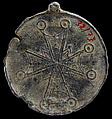Returned to lender The Met accepts temporary loans of art both for short-term exhibitions and for long-term display in its galleries.
Pilgrim Token with Image of Saint Symeon Stylites the Younger
Not on view
Stylites were ascetics who lived on platforms atop columns. This movement had practitioners into the nineteenth century, from Mosul in today’s northern Iraq to Gaul in France. Syria was home to large numbers of stylites, including the first stylite, Symeon Stylites the Elder (ca. 389–459).
Saint Symeon Stylites the Younger ended his life on the Wondrous Mountain, named after the miracles he worked there. Like Qal‘at Sem‘an, the mountain functioned as a pilgrimage site until the arrival of the Arabs and experienced a revival during the Byzantine reoccupation of the area from 969 to 1074. This lead medallion, inscribed in Greek and based on the iconography of sixth- and seventh-century clay tokens, was produced during this period.
Due to rights restrictions, this image cannot be enlarged, viewed at full screen, or downloaded.
This artwork is meant to be viewed from right to left. Scroll left to view more.



